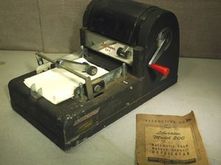
Bringing you news from the (spiritual) world outside, since 1944
On February 14, 1944, a group of devotees gathered to celebrate the appearance day of their spiritual master, Srila Bhaktisiddhanta Saraswati Thakura (1874-1937). Srila Bhaktisiddhanta had 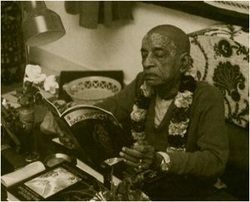 ordered one of them to spread Krishna consciousness in English. So now, on this auspicious day, that devotee, His Divine Grace A.C. Bhaktivedanta Swami Prabhupada, started the English magazine he would later refer to as the beginning of his spiritual life. In Srila Prabhupada-lilamrta, a six-volume biography, Satsvarupa Dasa Goswami tells of Prabhupada (then known as Abhay) working at home in Calcutta on his first issue: "From his front room at 6 Sita Kanta Banerjee, Abhay conceived, wrote, edited, and typed the manuscript for a magazine. He designed a logo, a long rectangle across the top of the page. In the upper left-hand corner was a figure of Lord Chaitanya, effulgent with rays of light like rays from the sun. In the lower right were silhouettes of a crowd of people, in darkness but groping to receive light from Lord Chaitanya. And between Lord Chaitanya and the people, the title unfurled like a banner—BACK TO GODHEAD. In the lower right corner was a picture of Srila Bhaktisiddhanta Saraswati seated at his writing, looking up thoughtfully as he composed. Above the logo ran the motto 'Godhead is Light, Nescience is darkness. Where there is Godhead there is no Nescience.'"
ordered one of them to spread Krishna consciousness in English. So now, on this auspicious day, that devotee, His Divine Grace A.C. Bhaktivedanta Swami Prabhupada, started the English magazine he would later refer to as the beginning of his spiritual life. In Srila Prabhupada-lilamrta, a six-volume biography, Satsvarupa Dasa Goswami tells of Prabhupada (then known as Abhay) working at home in Calcutta on his first issue: "From his front room at 6 Sita Kanta Banerjee, Abhay conceived, wrote, edited, and typed the manuscript for a magazine. He designed a logo, a long rectangle across the top of the page. In the upper left-hand corner was a figure of Lord Chaitanya, effulgent with rays of light like rays from the sun. In the lower right were silhouettes of a crowd of people, in darkness but groping to receive light from Lord Chaitanya. And between Lord Chaitanya and the people, the title unfurled like a banner—BACK TO GODHEAD. In the lower right corner was a picture of Srila Bhaktisiddhanta Saraswati seated at his writing, looking up thoughtfully as he composed. Above the logo ran the motto 'Godhead is Light, Nescience is darkness. Where there is Godhead there is no Nescience.'"
 ordered one of them to spread Krishna consciousness in English. So now, on this auspicious day, that devotee, His Divine Grace A.C. Bhaktivedanta Swami Prabhupada, started the English magazine he would later refer to as the beginning of his spiritual life. In Srila Prabhupada-lilamrta, a six-volume biography, Satsvarupa Dasa Goswami tells of Prabhupada (then known as Abhay) working at home in Calcutta on his first issue: "From his front room at 6 Sita Kanta Banerjee, Abhay conceived, wrote, edited, and typed the manuscript for a magazine. He designed a logo, a long rectangle across the top of the page. In the upper left-hand corner was a figure of Lord Chaitanya, effulgent with rays of light like rays from the sun. In the lower right were silhouettes of a crowd of people, in darkness but groping to receive light from Lord Chaitanya. And between Lord Chaitanya and the people, the title unfurled like a banner—BACK TO GODHEAD. In the lower right corner was a picture of Srila Bhaktisiddhanta Saraswati seated at his writing, looking up thoughtfully as he composed. Above the logo ran the motto 'Godhead is Light, Nescience is darkness. Where there is Godhead there is no Nescience.'"
ordered one of them to spread Krishna consciousness in English. So now, on this auspicious day, that devotee, His Divine Grace A.C. Bhaktivedanta Swami Prabhupada, started the English magazine he would later refer to as the beginning of his spiritual life. In Srila Prabhupada-lilamrta, a six-volume biography, Satsvarupa Dasa Goswami tells of Prabhupada (then known as Abhay) working at home in Calcutta on his first issue: "From his front room at 6 Sita Kanta Banerjee, Abhay conceived, wrote, edited, and typed the manuscript for a magazine. He designed a logo, a long rectangle across the top of the page. In the upper left-hand corner was a figure of Lord Chaitanya, effulgent with rays of light like rays from the sun. In the lower right were silhouettes of a crowd of people, in darkness but groping to receive light from Lord Chaitanya. And between Lord Chaitanya and the people, the title unfurled like a banner—BACK TO GODHEAD. In the lower right corner was a picture of Srila Bhaktisiddhanta Saraswati seated at his writing, looking up thoughtfully as he composed. Above the logo ran the motto 'Godhead is Light, Nescience is darkness. Where there is Godhead there is no Nescience.'"
Under Srila Prabhupada's supervision, the logo went through several changes over the years. But today, fifty years later, it still matches Srila Prabhupada's original idea. The only difference is that by the desire of his disciples Srila Prabhupada, rather than his spiritual master, now sits across from Lord Chaitanya.
Srila Prabhupada's purity and scholarship are now well known, and he is known for his books, his disciples, and his lifetime of devotion. But when he began Back to Godhead, few knew of his spiritual gifts, and fewer still came forward to help him.
In fact, between 1944 and 1960 Srila Prabhupada published most of the issues almost single-handedly. The magazine then was a tabloid—one sheet folded in half, making four pages of type. Srila Prabhupada wrote nearly all the articles, oversaw the printing, and sold or gave out every copy (one thousand per issue), mostly by approaching people on the street. Producing Back to Godhead was a struggle. In the very beginning, after Prabhupada had selected a printer and a distributor, he was denied paper. Because of World War II, India had a paper shortage. Srila Prabhupada persisted, however, and finally received permission to print his first issue—forty-four pages.
Satsvarupa Dasa Goswami writes: "It was 1944, and Abhay specifically addressed the crisis of world war. … After four years of fighting, costing millions of human lives, the second world war within twenty years was still scourging the earth.
"Abhay quoted the Archbishop of Canterbury:
In every quarter of earth men long to be delivered from the curse of War and to find, in a world which has regained its peace, respite from the harshness and bitterness of the world they have known till now. But so often they want the Kingdom of Heaven without its King, the kingdom of God without God. And they cannot have it.
Our resolve must be back to God. We make plans for the future for peace amongst nations and for civil security at home. That is quite right enough and it would be wrong to neglect it. But all our plans will come to shipwreck on the rock of human selfishness unless we turn to God. BACK TO GOD, that is the chief need of England and of every nation.
"Abhay told how he had come to begin Back to Godhead magazine—how he had written a letter [in the 1930s] two weeks before the disappearance of Srila Bhaktisiddhanta Saraswati Thakura, and how his spiritual master had instructed him to preach in English."
Prabhupada carried out this instruction by presenting an English magazine focusing on the concerns of the English-speaking world and written for people with Western sensibilities. The magazine offered translations and explanations of ancient Vedic texts alongside political and sociological commentaries, and spiritual views on current events. Srila Prabhupada wrote about subjects ranging from the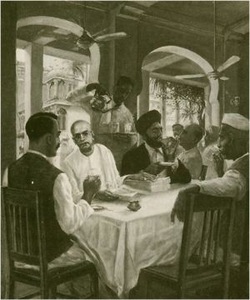 war to Theosophy to life on other planets. Times were tough, though, and money was scarce. And so, after only two issues, Srila Prabhupada had to stop printing. As the years passed, Prabhupada kept writing, and he kept meditating on how to spread Krishna consciousness. In 1952 he and his family moved to Allahabad, where he was able to revive Back to Godhead, making a new beginning in February 1952. He was still doing most of the writing, and all of the typing, editing, meeting with printers, and so on. But now, in Allahabad, he was better set up to distribute BTG to respectable Indian people and send it to important people around the world.
war to Theosophy to life on other planets. Times were tough, though, and money was scarce. And so, after only two issues, Srila Prabhupada had to stop printing. As the years passed, Prabhupada kept writing, and he kept meditating on how to spread Krishna consciousness. In 1952 he and his family moved to Allahabad, where he was able to revive Back to Godhead, making a new beginning in February 1952. He was still doing most of the writing, and all of the typing, editing, meeting with printers, and so on. But now, in Allahabad, he was better set up to distribute BTG to respectable Indian people and send it to important people around the world.
 war to Theosophy to life on other planets. Times were tough, though, and money was scarce. And so, after only two issues, Srila Prabhupada had to stop printing. As the years passed, Prabhupada kept writing, and he kept meditating on how to spread Krishna consciousness. In 1952 he and his family moved to Allahabad, where he was able to revive Back to Godhead, making a new beginning in February 1952. He was still doing most of the writing, and all of the typing, editing, meeting with printers, and so on. But now, in Allahabad, he was better set up to distribute BTG to respectable Indian people and send it to important people around the world.
war to Theosophy to life on other planets. Times were tough, though, and money was scarce. And so, after only two issues, Srila Prabhupada had to stop printing. As the years passed, Prabhupada kept writing, and he kept meditating on how to spread Krishna consciousness. In 1952 he and his family moved to Allahabad, where he was able to revive Back to Godhead, making a new beginning in February 1952. He was still doing most of the writing, and all of the typing, editing, meeting with printers, and so on. But now, in Allahabad, he was better set up to distribute BTG to respectable Indian people and send it to important people around the world.
He soon went to Jhansi, about four hundred miles west of Allahabad. There he met Acharya Prabhakar (then Prabhakar Misra), who was to become his first disciple. Together they continued printing Back to Godhead and canvassed for funding to keep it going.
Years later, when Prabhupada started printing and distributing the magazine in Delhi, he would go to tea stalls and
spend hours to sell even one copy.
In 1965 Srila Prabhupada traveled to the United States and opened the first center of the International Society for Krishna Consciousness (ISKCON), in New York City. Soon after, in October of 1966, he relaunched Back to Godhead. Srila Prabhupada gave the job of writing and publishing Back to Godhead to his first American disciples. The early issues were printed on a mimeograph machine Prabhupada bought secondhand from a country club in Queens. Setting a lofty goal, Srila Prabhupada told his disciples they should work hard and make BTG as popular as Time, Life, or Reader's Digest.
Though since then BTG has come a long way, it hasn't quite caught up with Time or Reader's Digest. And that's hardly surprising. Most people have yet to see the importance of self-realization. So they spend their money on magazines that speak to their conditioning and material desires. Despite religious and quasi-spiritual affiliations, they ultimately think the purpose of human life is to enjoy the senses. To them, self-realization is merely an addendum, some peripheral curiosity one can add, if one so chooses, to an otherwise full life of work and pleasure. They don't see themselves as essentially spiritual beings and therefore can't understand the relevance and urgency of Back to Godhead.
So when approaching people to try to interest them in BTG, devotees of Krishna 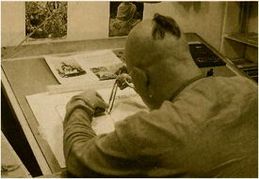 often find that people don't want to take the time. Prabhupada addressed this same concern years ago, in the March 1956 issue of BTG: When we approach some gentleman and request him to become a reader of "Back to Godhead," sometimes we are replied to with the words "no time." They say that they are too busy earning money for maintaining the body and soul together. But when we ask them what they mean by the "soul," they have nothing to reply. … But everybody should know from the Bhagavat Geeta that the body is the outward dress. … So if the dress is taken care of only, without any care of the real person—it is sheer foolishness and a waste of time.
often find that people don't want to take the time. Prabhupada addressed this same concern years ago, in the March 1956 issue of BTG: When we approach some gentleman and request him to become a reader of "Back to Godhead," sometimes we are replied to with the words "no time." They say that they are too busy earning money for maintaining the body and soul together. But when we ask them what they mean by the "soul," they have nothing to reply. … But everybody should know from the Bhagavat Geeta that the body is the outward dress. … So if the dress is taken care of only, without any care of the real person—it is sheer foolishness and a waste of time.
 often find that people don't want to take the time. Prabhupada addressed this same concern years ago, in the March 1956 issue of BTG: When we approach some gentleman and request him to become a reader of "Back to Godhead," sometimes we are replied to with the words "no time." They say that they are too busy earning money for maintaining the body and soul together. But when we ask them what they mean by the "soul," they have nothing to reply. … But everybody should know from the Bhagavat Geeta that the body is the outward dress. … So if the dress is taken care of only, without any care of the real person—it is sheer foolishness and a waste of time.
often find that people don't want to take the time. Prabhupada addressed this same concern years ago, in the March 1956 issue of BTG: When we approach some gentleman and request him to become a reader of "Back to Godhead," sometimes we are replied to with the words "no time." They say that they are too busy earning money for maintaining the body and soul together. But when we ask them what they mean by the "soul," they have nothing to reply. … But everybody should know from the Bhagavat Geeta that the body is the outward dress. … So if the dress is taken care of only, without any care of the real person—it is sheer foolishness and a waste of time.
Without understanding the science of Krishna consciousness, modern civilization treads a path that can only lead to pain: the path of misidentifying the body with the self. If someone thinks he is his clothes, he's going to feed his shirt and bathe his pants.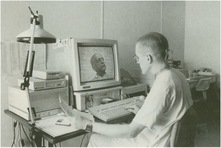 That is the situation today. Therefore, despite economic and scientific advancement, people are dissatisfied.Back to Godhead aims to deliver people from their dissatisfaction by shining the light of Krishna consciousness into the darkness of the modern age. Despite obstacles, Back to Godhead continues to pursue the goal for which it was started: the respiritualization of human society. People who don't take advantage of Back to Godhead are missing a golden opportunity to respiritualize their consciousness.
That is the situation today. Therefore, despite economic and scientific advancement, people are dissatisfied.Back to Godhead aims to deliver people from their dissatisfaction by shining the light of Krishna consciousness into the darkness of the modern age. Despite obstacles, Back to Godhead continues to pursue the goal for which it was started: the respiritualization of human society. People who don't take advantage of Back to Godhead are missing a golden opportunity to respiritualize their consciousness.
 That is the situation today. Therefore, despite economic and scientific advancement, people are dissatisfied.Back to Godhead aims to deliver people from their dissatisfaction by shining the light of Krishna consciousness into the darkness of the modern age. Despite obstacles, Back to Godhead continues to pursue the goal for which it was started: the respiritualization of human society. People who don't take advantage of Back to Godhead are missing a golden opportunity to respiritualize their consciousness.
That is the situation today. Therefore, despite economic and scientific advancement, people are dissatisfied.Back to Godhead aims to deliver people from their dissatisfaction by shining the light of Krishna consciousness into the darkness of the modern age. Despite obstacles, Back to Godhead continues to pursue the goal for which it was started: the respiritualization of human society. People who don't take advantage of Back to Godhead are missing a golden opportunity to respiritualize their consciousness.
Those with insight and sincerity of heart will take this opportunity to become like one of those people on the BTG logo and move toward Chaitanya Mahaprabhu, the golden incarnation of Lord Krishna.


